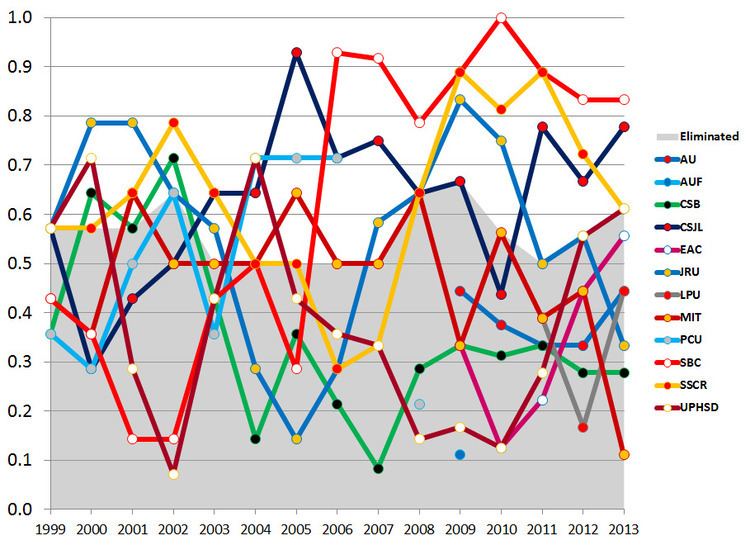1 Semifinals seed | ||
 | ||
The NCAA Final Four most often refers to the playoffs of the National Collegiate Athletic Association (Philippines) (NCAA) seniors' basketball tournament.
Contents
- Format
- Appearances
- Finals statistics
- Semifinals
- Most frequent matchups
- Seeds
- Individual single game records
- Television and radio
- References
The term "final four" came from National Collegiate Athletic Association of the United States' men's Division I basketball tournament which is colloquially called as the "final four".
The final four was instituted in 1998; prior to that the first and second round winners, plus the team with the best overall standing if it did not win either round, participated in the championship round to determine the champion.
Format
Appearances
Notes:
Finals statistics
Semifinals
Most frequent matchups
The twelve most frequently played matchups are:
Seeds
In the 11 tournaments the Final Four format has been applied, the higher seed has beaten the lower seeds in the semifinals due to their twice to beat advantage, for the most part:
- The #1 seed has beaten the #4 seed 15 times (83%)
- The #1 seed has beaten the #4 seed 3 times on the second game (27%)
- The #2 seed has beaten the #3 seed 16 times (89%).
- The #2 seed has beaten the #3 seed 5 times on the second game (28%).
- The #3 seed has beaten the #4 once
- With San Beda sweeping the elimination round, there were two semifinal rounds for 2010.
- The #1 seed skipped the semifinals once (5%; in 2010, when San Beda swept the elimination round)
A victory of the #3 and #4 seeds in a series are considered big upsets considering that the #3 and #4 seed have to win twice, not to mention the perceived superiority of the #1 and #2 seeds when compared to the #3 and #4 seeds.
In the finals, the advantage of the #1 seed isn't as pronounced since the competing teams have to win the same number of games:
- The #1 seed has beaten the #2 seed 11 times (61%)
- The #2 seed has beaten the #1 seed 4 times (22%)
- The #3 seed has beaten the #4 seed 1 time (9%)
- This occurred in 2000 in which both lower seeded teams upset the teams with the twice to beat advantage. This was the only time were both teams possessing the twice to beat advantage failed to qualify for the finals in both the NCAA and the UAAP.
- The #4 seed has beaten the #2 seed 1 time (9%)
- The #1 seed has won the championship 12 times (67%)
Individual single-game records
Stats since the 2001 season.
*overtime game
**double overtime game
Appearances
Notes:
Television and radio
The Final Four is the culmination of the NCAA basketball season and is heavily covered by the media. With the NCAA as one of the leading collegiate leagues in the country, the Final Four games are broadcast live throughout the country.
Beginning in 2015, the NCAA, and the Final Four games, are broadcast by ABS-CBN's UHF channel ABS-CBN Sports+Action nationwide, being produced by ABS-CBN Sports. Previously, Studio 23 covered the NCAA from 2002 until 2011. Prior to Studio 23, the games were broadcast irregularly by different broadcast partners. From 2009 to 2011 and since 2015, the games are also aired in high definition, through Balls subsidiary Balls HD.
Previous nationwide providers of the NCAA were GMA Network from 1974 until 1988, Vintage Television on IBC from 1998 until 1999 and PTV Channel 4 from 2000 until 2001 season. PTV's coverage was produced by MCI Group and later Silvestar Sports.
In 2012, the NCAA, and the Final Four games were broadcast by TV5's VHF channel IBC's AKTV, being produced by Sports5. From 2013 to 2014 TV5 took over the seniors' games coverage after AKTV was dissolved.
